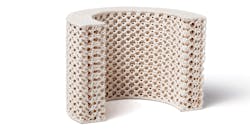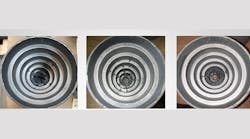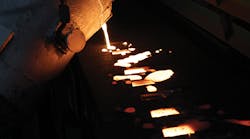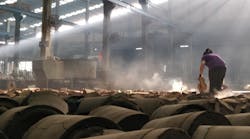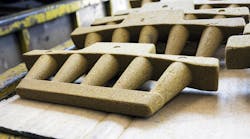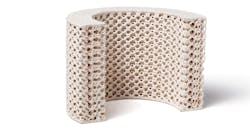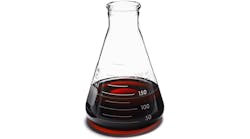The first myth relates to a recent problem with slag at a large iron foundry in Mexico. They had recently switched resins, and after the switch they experienced an increase in slag defects. Of course, the resin had to be at fault! After a statistical review of all resin
parameters and a discussion of how slag is formed, it became clear that resin could not the cause of slag defects. Historical research supported by several foundries, universities, and AFS has been consistent on this issue.
Slag can be characterized as a mixture of metal oxides that occurs in an oxidizing atmosphere. An oxidizing atmosphere is nothing more than an O2-rich environment that promotes certain chemical reactions, such as oxidation and corrosion. The decomposition products that form inside a no-bake or green-sand mold create a reducing environment. A reducing atmosphere is an O2-starved environment in which oxidation is prevented by removal of oxygen and other oxidizing gases / vapors. Such an environment contains high concentrations of actively reducing gases, such as hydrogen, carbon monoxide, and hydrogen sulfide. As such, the reducing environment within no-bake and green-sand molds inhibits slag formation.”1 In the end, the customer confirmed this long-held wisdom when they shifted the focus to other potential sources of slag formation, and actually identified the true cause of the problem.
A second long-standing myth about PUNB operations involves the diagnostic value of a non-homogeneous gel, or other observations from the gel time test. In general, these gels are thought to predict curing characteristics, strength performance, and even gas-related casting defects. The prospect of predicting molding performance can be alluring. The test is simple. The results are visual. The implications are clear, right?
Not necessarily. At high catalyst concentrations, typically above recommended levels, a gel test might exhibit a phase-separation of the solvents from the polymer matrix. When viewed versus a “normal” gel, the difference can be dramatic, but this does not mean something is wrong.
On the contrary, volatile solvents being expelled from the polyurethane matrix often lead to better casting quality. One customer who pushed a PUNB process to cure faster in this manner found that casting porosity defects decreased. When the molding process was slowed, solvents became entrapped in the resin matrix and could not evaporate before pouring. The resulting mold generated significantly more gas, and at a higher rate, during casting — resulting is gas-related defects. The gel test is fast, easy, and inexpensive, but it is not a great predictor of molding performance or casting quality, and it is no substitute for well-designed sand and/or casting testing.
Finally, there is an idea that’s thought to be grounded in science and common sense, making it one of the more emotionally difficult myths to bust. It is common knowledge that sand temperature is one of the most (if not the most) important variables in determining work time/strip time in no-bake molding. It is a variable that must be controlled in order to have consistent molding results. On that, there is no debate. However, a recent laboratory experimental design (DOE) was completed that shows that sand ADV is an even more important factor — and has more influence on WT/ST — than does sand temperature. This doesn’t violate science by any means, but it does open our eyes to another factor that needs to have prominence when running a no-bake operation. So, perhaps, this might not be considered a myth, but a misunderstanding. In any case, sand ADV, catalyst amount, and sand temperature are the big three factors when trying to control no-bake mixed sand WT/ST. Any molding manager must manage all three to ensure success.
Only a handful of foundries use these busted myths to advantage and these seem to have three things in common: They have the most productive no-bake processes, the highest level of casting quality, and the highest level of overall profitability. Don’t commit the three classic blunders. Become your own “myth buster.”
1. “Slag’s Effects on Cast Iron & Steel Production”. S. Katz. AFS Transactions 2004.
Join the Conversation. Email Your Questions for ASK Chemicals
Share your insights, opinions, and elaborate on the questions and the experts' answer(s). You must be logged in to the website in order to post your comments.
